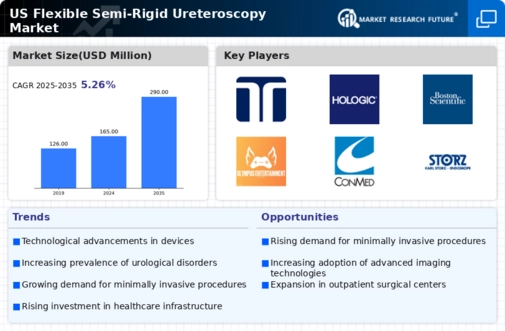Increasing Healthcare Expenditure
The flexible semi-rigid-ureteroscopy market benefits from the rising healthcare expenditure in the United States. As healthcare budgets expand, hospitals and clinics are more inclined to invest in advanced medical technologies and equipment. This trend is particularly evident in urology departments, where the demand for effective treatment options for urological disorders is on the rise. According to recent statistics, healthcare spending in the U.S. is projected to reach $4.1 trillion by 2025, with a significant portion allocated to surgical interventions. This increase in funding is likely to bolster the flexible semi-rigid-ureteroscopy market, as healthcare providers seek to enhance their service offerings and improve patient care.
Growing Awareness of Urological Health
There is a growing awareness of urological health issues among the general population, which is positively impacting the flexible semi-rigid-ureteroscopy market. Educational campaigns and initiatives aimed at promoting urological health have led to increased screening and early diagnosis of conditions such as kidney stones and urinary tract infections. This heightened awareness is likely to drive demand for flexible semi-rigid-ureteroscopy procedures, as patients seek timely and effective treatment options. Market analysts suggest that this trend could result in a 20% increase in the number of procedures performed annually, further propelling the growth of the flexible semi-rigid-ureteroscopy market.
Technological Innovations in Ureteroscopy
Technological innovations play a crucial role in shaping the flexible semi-rigid-ureteroscopy market. The introduction of advanced imaging techniques, such as high-definition cameras and digital enhancements, has significantly improved the visualization of urinary tract conditions. These innovations not only enhance the precision of diagnoses but also facilitate more effective treatment options. Furthermore, the integration of robotics and automation in ureteroscopy procedures is expected to increase efficiency and accuracy. Market data indicates that the adoption of these technologies could lead to a projected growth rate of 15% in the flexible semi-rigid-ureteroscopy market over the next five years, as healthcare facilities invest in state-of-the-art equipment to improve patient outcomes.
Aging Population and Associated Health Issues
The aging population in the United States is a significant driver of the flexible semi-rigid-ureteroscopy market. As individuals age, they become more susceptible to various urological disorders, including kidney stones and benign prostatic hyperplasia. The demographic shift towards an older population is expected to increase the demand for urological interventions, including flexible semi-rigid-ureteroscopy procedures. Current projections indicate that by 2030, approximately 20% of the U.S. population will be over 65 years old, creating a substantial market for urological treatments. This demographic trend suggests a sustained growth trajectory for the flexible semi-rigid-ureteroscopy market as healthcare providers adapt to meet the needs of an aging patient population.
Rising Demand for Minimally Invasive Procedures
the flexible semi-rigid-ureteroscopy market is experiencing a notable surge in demand driven by the increasing preference for minimally invasive surgical techniques. Patients and healthcare providers alike favor these procedures as they typically result in reduced recovery times, less postoperative pain, and minimal scarring. According to recent data, minimally invasive surgeries have seen an adoption rate increase of approximately 30% in the last few years. This trend is likely to continue, as advancements in technology further enhance the efficacy and safety of flexible semi-rigid-ureteroscopy procedures. As a result, the market is poised for growth, driven by the need for effective treatment options that align with patient preferences for less invasive interventions.






















Leave a Comment